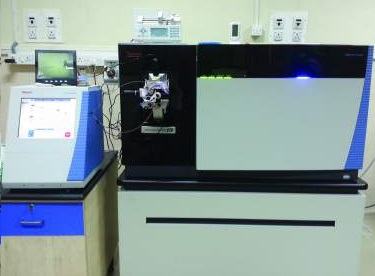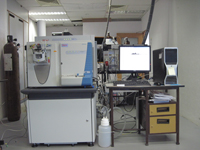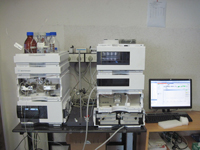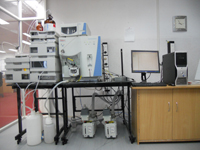Facilities |
|
|
Existing Facilities at IOB:
Laboratory For its current operations, IOB (established in 2002, recognized as a SIRO by DSIR in 2004 onwards, recognized by Pondicherry, Amrita, Kuvempu and Manipal Universities as a Research Centre for Ph.D. studies) has computational facilities, a molecular biology laboratory, a cell culture facility, immunohistochemistry platform, a mass spectrometry and a genomics laboratory. Using cutting edge technologies such as DNA microarrays and quantitative mass spectrometry, scientists at IOB are carrying out gene expression profiling, identifying genome copy number variations, profiling micro RNA expression and studying methylation status on a genomewide scale. Proteomics methodologies such as GST pulldown assays, Western blotting and transfection studies are routinely used to study cellular signaling pathways. Molecular biology experiments include cell culture, DNA and RNA isolation, cloning and quantitative real time PCR to study signaling pathways in various cancers and neurological disorders. Using quantitative mass spectrometry, scientists at IOB are carrying out differential proteomic analysis in various cancers and neurological diseases to discover molecule associations and candidate biomarkers in these diseases. To translate discovery from bench to bedside, an immunohistochemistry platform is also available and is coupled with tissue microarray capability. Using high resolution mass spectrometer, we are carrying out proteomic profiling of different organisms both sequenced and unsequenced ones and annotating their genomes by searching against genome database. Proteomics facility Scientists at IOB have optimized methods for nanoflow liquid chromatography, which is used in almost all proteomics experiments today. We have developed strategies for both online and offline multidimensional chromatography (MUDPIT) for extensive separation and fractionation of samples. We have pioneered the use of in vivo labeling strategies such as SILAC (stable isotope labeling with amino acids in cell culture), a technology that is currently being used by numerous groups around the world. We are also experts in other quantitative labeling methodologies such as 18O labeling and iTRAQ – in fact, we were early adopters of the 8-plex labeling reagents. We were also the first to apply a novel mass spectrometric technology, Electron Transfer Dissociation (ETD), for a global phosphoproteomic analysis. A Fourier transform mass spectrometer with electron transfer dissociation capabilities (Orbitrap Velos with ETD) is an integral part of the mass spectrometry infrastructure at IOB. We have recently procured The TSQ Quantum Ultra, which is a high performance triple stage quadrupole mass spectrometer, which provides greater analytical selectivity. This mass spectrometer uses several different scan modes and enables constant neutral loss scanning, parent scanning, high-resolution precursor ion selectivity, Selected Reaction Monitoring (SRM), Highly Selective Reaction Monitoring (H-SRM) and Multiple Reaction Monitoring (MRM). We are using TSQ Quantum Ultra to validate candidate biomarkers in CSF, serum, urine and other body fluids. We are also equipped with reverse phase and strong cation exchange columns for protein/peptide fractionation. Computational facility Under the “DBT Programme Support on Neuroproteomics for Proteomic Investigation of Neurological Disorders,” IOB has setup a state-of-the-art computational infrastructure for the proteomics facility. The computational infrastructure includes a 64-Core Linux Cluster, 10 high-end Sun Fire Servers and a network attached storage server with 12 Tera Bytes of storage capacity. Additionally, 50 thin-clients which include 40 Linux workstations and 10 Windows Server workstations have been installed which share the central storage server. The Linux Cluster has been used for running algorithms for database searching of mass spectrometry derived data. The algorithms include Mascot and parallelized version of X! Tandem. The serial algorithm servers have been used for other database searching algorithms including OMSSA, Spectrum Mill, Inspect and SEQUEST. Additionally, this infrastructure is also used for development of a mass spectrometry data analysis pipeline BioDiscoverer. Library Facilities • A library with books of biomedical relevance • Availability of full text subscription for over 2500 biomedical journals • Weldoc facility for processing full text requests from journals not included in the above mentioned 2500 |

Orbitrap Fusion Tribid mass spectrometer 
LTQ Orbitrap Velos mass spectrometer  High Performance liquid chromatography  TSQ-Quantum Ultra Triple Stage Quadrupole mass spectrometer |